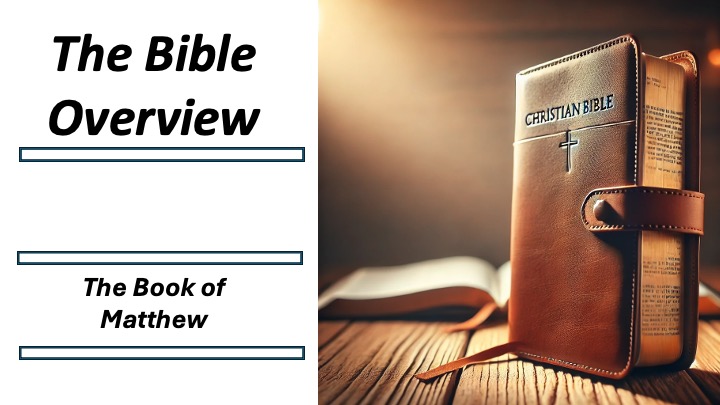Bible Overview Matthew
Mike Ervin

Gospel
of Matthew: Overview
Authorship
Traditional View:
• Attributed to Matthew (Levi), the tax collector, one of Jesus’ twelve
disciples.
• Early church fathers (Papias, Irenaeus, Origen) affirm Matthew as the author,
possibly writing in Hebrew or Aramaic before being translated into Greek.
Modern Scholarly View:
• Many scholars believe Matthew used Mark’s Gospel as a source, along with the
hypothetical Q source.
• Some question direct authorship by the apostle but acknowledge it was likely
written by a Jewish Christian with strong knowledge of the Old Testament.
Date of Authorship
• Traditional View: Written in the 50s–60s AD, possibly before the destruction
of the Temple in 70 AD.
• Modern View: Most scholars date it between 70–90 AD, due to references
suggesting awareness of the Temple’s destruction (Matt. 24).
Intended Audience
• Primarily Jewish Christians, evident from the heavy use of Old Testament
prophecy to show Jesus as the Messianic King.
• Also includes Gentile inclusion, especially in the Great Commission (Matt.
28:19-20).
Major Themes
1. Jesus as the Fulfillment of Old Testament Prophecy – Frequent citations of
Messianic prophecies.
2. The Kingdom of Heaven – Unique to Matthew, emphasizing Jesus as King.
3. Jesus as the New Moses – Giving a new law (Sermon on the Mount).
4. Discipleship & Ethics – Emphasis on righteousness, humility, and
obedience.
5. Judgment & Salvation – Strong focus on final judgment and parables of
the kingdom.
Chapter-by-Chapter Summary
I. Birth & Early Ministry (Ch. 1–4)
• Ch. 1 – Genealogy of Jesus, linking Him to Abraham and David.
• Ch. 2 – Visit of the Magi; escape to Egypt.
• Ch. 3 – John the Baptist and Jesus’ baptism.
• Ch. 4 – Temptation in the wilderness; calls first disciples.
II. Teachings & Miracles (Ch. 5–15)
• Ch. 5–7 – Sermon on the Mount (Beatitudes, Lord’s Prayer, ethical teachings).
• Ch. 8–9 – Miracles demonstrating Jesus’ authority.
• Ch. 10 – Mission of the twelve disciples.
• Ch. 11–12 – Reactions to Jesus; conflict with Pharisees.
• Ch. 13 – Parables of the Kingdom (sower, weeds, mustard seed).
III. Growing Opposition & Discipleship (Ch. 16–23)
• Ch. 16 – Peter’s confession (“You are the Christ”).
• Ch. 17 – Transfiguration of Jesus.
• Ch. 18–19 – Teachings on forgiveness, humility, and marriage.
• Ch. 20–21 – Triumphal Entry; cleansing of the Temple.
• Ch. 22–23 – Warnings against the Pharisees’ hypocrisy.
IV. Passion & Resurrection (Ch. 24–28)
• Ch. 24–25 – Olivet Discourse (end times & final judgment).
• Ch. 26–27 – Betrayal, trial, crucifixion, and burial.
• Ch. 28 – Resurrection and the Great Commission.